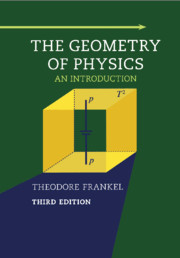Book contents
- Frontmatter
- Contents
- Preface to the Third Edition
- Preface to the Second Edition
- Preface to the Revised Printing
- Preface to the First Edition
- Overview. An Informal Overview of Cartan's Exterior Differential Forms, Illustrated with an Application to Cauchy's Stress Tensor
- I Manifolds, Tensors, and Exterior Forms
- II Geometry and Topology
- III Lie Groups, Bundles, and Chern Forms
- Appendix A Forms in Continuum Mechanics
- Appendix B Harmonic Chains and Kirchhoff's Circuit Laws
- Appendix C Symmetries, Quarks, and Meson Masses
- Appendix D Representations and Hyperelastic Bodies
- Appendix E Orbits and Morse–Bott Theory in Compact Lie Groups
- References
- Index
Overview. An Informal Overview of Cartan's Exterior Differential Forms, Illustrated with an Application to Cauchy's Stress Tensor
Published online by Cambridge University Press: 05 June 2012
- Frontmatter
- Contents
- Preface to the Third Edition
- Preface to the Second Edition
- Preface to the Revised Printing
- Preface to the First Edition
- Overview. An Informal Overview of Cartan's Exterior Differential Forms, Illustrated with an Application to Cauchy's Stress Tensor
- I Manifolds, Tensors, and Exterior Forms
- II Geometry and Topology
- III Lie Groups, Bundles, and Chern Forms
- Appendix A Forms in Continuum Mechanics
- Appendix B Harmonic Chains and Kirchhoff's Circuit Laws
- Appendix C Symmetries, Quarks, and Meson Masses
- Appendix D Representations and Hyperelastic Bodies
- Appendix E Orbits and Morse–Bott Theory in Compact Lie Groups
- References
- Index
Summary
Introduction
Introduction
My goal in this overview is to introduce exterior calculus in a brief and informal way that leads directly to their use in engineering and physics, both in basic physical concepts and in specific engineering calculations. The presentation will be very informal. Many times a proof will be omitted so that we can get quickly to a calculation. In some “proofs” we shall look only at a typical term.
The chief mathematical prerequisites for this overview are sophomore courses dealing with basic linear algebra, partial derivatives, multiple integrals, and tangent vectors to parameterized curves, but not necessarily “vector calculus,” i.e., curls, divergences, line and surface integrals, Stokes' theorem,.… These last topics will be sketched here using Cartan's “exterior calculus.”
We shall take advantage of the fact that most engineers live in euclidean 3-space ℝ3 with its everyday metric structure, but we shall try to use methods that make sense in much more general situations. Instead of including exercises we shall consider, in the section Elasticity and Stresses, one main example and illustrate everything in terms of this example but hopefully the general principles will be clear. This engineering example will be the following. Take an elastic circular cylindrical rod of radius a and length L, described in cylindrical coordinates r, θ, z, with the ends of the cylinder at z = 0 and z = L.
- Type
- Chapter
- Information
- The Geometry of PhysicsAn Introduction, pp. xxix - lxiiPublisher: Cambridge University PressPrint publication year: 2011



